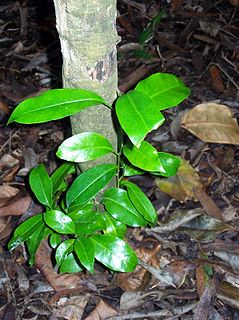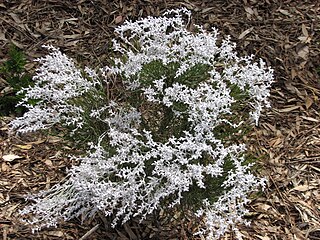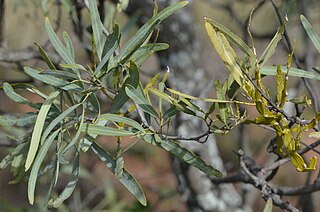
Fontainea is a genus constituting part of the plant family Euphorbiaceae. The nine currently known species grow naturally in Queensland (Qld) and New South Wales (NSW) Australia, New Caledonia and Vanuatu, and Papua New Guinea. Some species are commonly named blushwood.

Baloghia is a genus of plants under the family Euphorbiaceae first described as a genus in 1833. It is native to Australia, New Caledonia, and Vanuatu. Cocconerion is a close relative.

Henri Ernest Baillon was a French botanist and physician. He was born in Calais on 30 November 1827 and died in Paris on 19 July 1895.
Banksia proteoides, commonly known as king dryandra, is a shrub endemic to Western Australia. It was known as Dryandra proteoides until 2007, when all Dryandra species were transferred to Banksia by Austin Mast and Kevin Thiele.

Storckiella is a genus of four recognised species of trees, of the legume plant family, Fabaceae. They grow naturally in New Caledonia, Fiji and Australia.

Xanthostemon is a genus of trees and shrubs, constituting part of the myrtle plant family Myrtaceae. This genus was first described in 1857 by German–Australian botanist Ferdinand von Mueller. According to different official sources between 46 and 51 species are known to science. They grow naturally in New Caledonia, Australia, the Solomon Islands and Malesia, including the Philippines, New Guinea and Indonesia. The genera Pleurocalyptus and Purpureostemon from New Caledonia are morphologically close to Xanthostemon.

Conospermum stoechadis, commonly known as common smokebush, is a shrub endemic to Western Australia.
Euphorbia tannensis is a species of herb or shrub native to Australia and some Pacific islands.
Melaleuca pancheri is a shrub or small tree in the myrtle family, Myrtaceae and is endemic to the south of Grande Terre, the main island of New Caledonia. It is one of only a few members of its genus to occur outside Australia and was formerly known as Callistemon pancheri Brongn. & Gris.

Deplanchea is a genus of about eight species of tropical rainforest trees, constituting part of the plant family Bignoniaceae.
Dubouzetia is a genus of about eleven species known to science, growing from shrubs up to large trees, in Papuasia and Australasia and constituting part of the plant family Elaeocarpaceae.
Eugene Vieillard (1819–1896) was a French physician and botanist.
Jean Armand Isidore Pancher was a French gardener and botanist.

Korthalsella rubra is a flowering plant in the Santalaceae (sandalwood) family, formerly placed in the Viscaceae.
Fontainea fugax is a shrub endemic to Queensland, in the family, Euphorbiaceae, growing up to 4 m. In 1997, F. fugax was considered "endangered" having been found in only in the central Burnett district and within an endangered community, threatened by weeds, repeated fires and clearing.
Fontainea borealis is a small tree endemic to Papua New Guinea, in the family, Euphorbiaceae, which grows to a height of 12 m.
Fontainea subpapuana is a small tree endemic to Papua New Guinea in the family, Euphorbiaceae, which grows to a height of 7 m.

Bertya opponens, is a shrub/tree in the family Euphorbiaceae, native to Australia and found in New South Wales and Queensland. It is found on ridges amongst mallee in shallow soils. It flowers in July and August.

Beyeria lechenaultii is a species of flowering plant in the spurge family, Euphorbiaceae, that is endemic to Australia.

Bouchardatia neurococca, commonly known as union nut, is a species of small rainforest tree that is endemic to eastern Australia. It has pinnate leaves with three or five narrow elliptical leaflets, white flowers arranged in panicles, and oval follicles.











